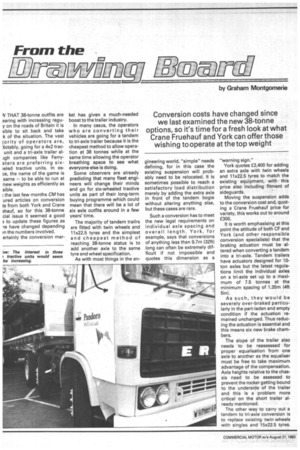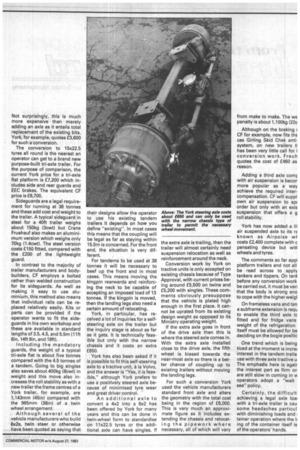From the i=7 I h c MWEBD MITO1
Page 28

Page 29

If you've noticed an error in this article please click here to report it so we can fix it.
IV THAT 38-tonne outfits are Baring with increasing reguy on the roads of Britain it is sible to sit back and take k of the situation. The vast jority of operators are, Jictably, going for a 4x2 tracunit and a tri-axle trailer alJgh companies like Ferrysters are preferring sixieled tractive units. In esce, the name of the game is same — to be able to run at new weights as efficiently as sible.
the last few months CM has ured articles on conversion ts from both York and Crane .Thauf, so for this 38-tonne cial issue it seemed a good 3 to update these figures as le have changed depending in the numbers involved.
ertainly the conversion mar ket has given a much-needed boost to the trailer industry.
In many cases, the operators who are converting their vehicles are going for a tandem to tri-axle trailer because it is the cheapest method to allow operation at 38 tonnes while at the same time allowing the operator breathing space to see what everyone else is doing.
Some observers are already predicting that many fleet engineers will change their minds and go for six-wheeled tractive units as part of their long-term buying programme which could mean that there will be a lot of six axle outfits around in a few years' time.
The majority of tandem trailrs are fitted with twin wheels and 11x22.5 tyres and the simplest and cheapest method of reaching 38-tonne status is to add another axle to the same tyre and wheel specification.
As with most things in the en
gineering world, "simple" needs defining, for in this case the existing suspension will probably need to be relocated. It is sometimes possible to reach a satisfactory load distribution merely by adding the extra axle in front of the tandem bogie without altering anything else, but these cases are rare.
Such a conversion has to meet the new legal requirements on individual axle spacing and overall length. York, for example, says that conversions of anything less than 9.7m (32ft) long can often be extremely difficult if not impossible and quotes this dimension as a "warning sign."
York quotes £2,400 for adding an extra axle with twin wheels and 11x22.5 tyres to match the existing equipment, with this price also including fitment of sideguards.
Moving the suspension adds to the conversion cost and, quoting a Crane Fruehauf price for variety, this works out to around £300.
It is worth emphasising at this point the attitude of both CF and York (and other responsible conversion specialists) that the braking actuation must be altered when converting a tandem into a tri-axle. Tandem trailers have actuators designed for 10ton axles but the latest regulations limit the individual axles on a tri-axle set up to a maximum of 7.5 tonnes at the minimum spacing of 1.35m (4ft Sin).
As such, they would be severely over-braked particularly in the part-laden and empty condition if the actuation remained unchanged. Thus reducing the actuation is essential and this means six new brake chambers.
The slope of the trailer also needs to be reassessed for proper equalisation from one axle to another as the equaliser must be free to take maximum advantage of the compensation. Axle heights relative to the chassis need to be assessed to prevent the rocker getting bound to the underside of the trailer and this is a problem more critical on the short trailer already mentioned.
The other way to carry out a tandem to tri-axle conversion is to replace existing twin wheels with singles and 15x22.5 tyres. Not surprisingly, this is much more expensive than merely adding an axle as it entails total replacement of the existing bits. York, for example, quotes £3,600 for such a conversion.
The conversion to 15x22.5 tyres all round is the nearest an operator can get to a brand new purpose-built tri-axle trailer. For the purpose of comparison, the current York price for a tri-axle flat platform is £7,200 which includes side and rear guards and EEC brakes. The equivalent CF price is £8,700.
Sideguards are a legal requirement for running at 38 tonnes and these add cost and weight to the trailer. A typical sideguard in steel for a 40ft trailer weighs about 150kg (3cwt) but Crane Fruehauf also makes an aluminimum version which weighs only 70kg (1.4cwt). The steel version costs £150 fitted, compared with the £200 of the lightweight guard.
In contrast to the majority of trailer manufacturers and bodybuilders, CF employs a bolted rather than welded construction for its sideguards. As well as making it easy to use aluminium, this method also means that individual rails can be replaced relatively easily. Kits or parts can be provided if the operator wants to fit the sideguards in his own workshop and these are available in standard lengths of 3.5, 4.5, and 5.5m (lift 6in, 14ft 9in, and 18ft).
Including the mandatory guards, the weight of a typical tri-axle flat is about five tonnes compared with the 4.5 tonnes of a tandem. Going to big singles also saves about 400kg (8cwt) in weight and this move also increases the roll stability as with a new trailer the frame centres of a York trailer, for example, are 1,143mm (45in) compared with the 965mm (38in) of a twin wheel arrangement.
Although several of the vehicle manufacturers who build 6x2s, twin steer or otherwise have been quoted as saying that their designs allow the operator to use his existing tandem trailers it depends on how you define "existing". In most cases this means that the coupling will be legal as far as staying within 15.5m is concerned. For the front end, the situation is very different.
For tandems to be used at 38 tonnes it will be necessary to beef up the front end in most cases. This means moving the kingpin rearwards and reinforcing the neck to be capable of accepting an imposed load of 13 tonnes. If the kingpin is moved, then the landing legs also need a certain amount of relocating.
York, in particular, has received a lot of inquiries for a selfsteering axle on the trailer but the inquiry stage is about as far as it gets. It is technically feasible but only with the narrow chassis and it costs an extra £650.
York has also been asked if it is possible to fit this self-steering axle to a tractive unit, a la Volvo, and the answer is "Yes, it is feasible," although York prefers to use a positively steered axle because of minimised tyre wear and great driver control.
An additional axle to convert a 4x2 into a 6x2 has been offered by York for many years and this can be done in twin-wheel form to standardise on 11x22.5 tyres or the additional axle can have singles. If the extra axle is trailing, then the trailer will almost certainly need suspension relocation as well as reinforcement around the neck.
Conversion work by York on tractive units is only accepted on existing chassis because of Type Approval, with current prices being around £5,500 on twins and £5,200 with singles. These comments obviously presuppose that the vehicle is plated high enough in the first place. It cannot be uprated from its existing design weight as opposed to its Ministry operating weight.
If the extra axle goes in front of the drive axle then this is where the steered axle comes in. With the extra axle installed close to the drive axle, the fifth wheel is biased towards the near-most axle so there is a better chance of coupling up to existing trailers without moving the landing legs.
For such a conversion York used the vehicle manufacturers standard front axle and alters the geometry with the total cost being in the region of £6,000. This is very much an approximate figure as it includes extending the chassis and relocating the pipework where necessary, all of which will vary
from make to make. The WE penalty is about 1,100kg (22c
Although on the braking ; CF for example, now fits thE cas Girling Skid Chek antisystem, on new trailers tl has been very little call for i conversion work. Freuh quotes the cost of £460 as reason.
Adding a third axle comr with air suspension is becor more popular as a way achieve the required intercompensation. CF will suppl own air suspension to so( order but only with an exis suspension that offers a g roll stability.
York has now added a lii air suspended axle to its rE known as Airpoise costs £2,400 complete with c pensating device but witl wheels and tyres.
The comments so far appl platform trailers and not all be read across to apply tankers and tippers. On tank before any conversion work be carried out, it must be veri that the body is strong eno to cope with the higher weigl On frameless vans and tan a subframe extension is requ to enable the third axle tc fitted and for fridge vans weight of the refrigeration itself must be allowed for be deciding on the bogie positic One trend which is being ticed at the moment is incre interest in the tandem traile use with three axle tractive u The emphasis here is agair the interest part as firm or are still slow in coming in v■ operators adopt a "wait see" policy.
Certainly, the difficult achieving a legal axle loai with a tri-axle trailer is cau some headaches particul with diminishing loads and tamer operation where the 11 ing of the container itself is of the operators' hands.




























































































































